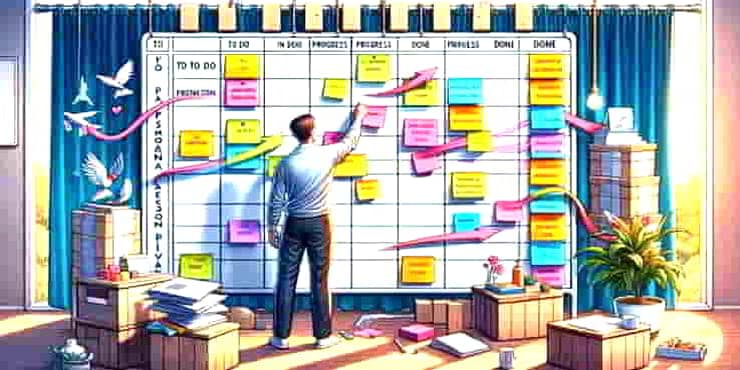Personal Kanban: Managing Tasks, Projects, and Awesome Workflows

Estimated reading time: 6 Min
Managing tasks, projects, and workflows efficiently is more important now than ever. Enter Personal Kanban, which simplifies how we tackle our to-do lists.
Originating from the Japanese manufacturing sector, Kanban has evolved into a powerful tool for personal and professional productivity
By visualising tasks and limiting work in progress, personal Kanban provides a clear path through our daily and long-term obligations.
This article explores the foundations of personal Kanban, its benefits, and how you can apply it to manage your life with more clarity and less stress.
Understanding Personal Kanban
Definition of Kanban Kanban, Japanese for “signboard” or “billboard,” is a visual management method that helps track work as it progresses through a process.
The essence of Kanban is to visualise both the process (the workflow) and the actual work passing through that process.
The goal is to identify any bottlenecks in the process and allow for easy changes to improve flow.
The Philosophy Behind Personal Kanban At its core, personal Kanban is about understanding and improving how you work.
It’s built on two fundamental principles: visualise your work and limit your work in progress.
By seeing all your tasks laid out before you, you can better manage your time and make informed decisions about what to tackle next.
Limiting work in progress, on the other hand, helps prevent overwhelm and ensures you’re focusing on what matters most.
Key Components of Personal Kanban The two pillars of Personal Kanban—visualization and limiting work in progress—work together to streamline how you approach tasks.
Visualisation is achieved through the use of a Kanban board, a simple tool where tasks are represented on cards and moved across columns that represent different stages of the workflow.
Limiting work in progress (WIP) involves setting a maximum number of tasks you can work on in each stage, preventing over-commitment, and promoting focus.
Benefits of Personal Kanban
Adopting personal Kanban can transform your approach to managing tasks and projects. Here are some of the key benefits:
- Increased Productivity and Efficiency
By visualising your tasks, you can easily see what needs to be done and identify the most efficient path to completion. This clarity reduces the time spent deciding what to work on next. - Enhanced Focus and Clarity
Limiting work in progress forces you to concentrate on a smaller number of tasks, reducing distraction and improving quality. - Flexibility and Adaptability
Personal Kanban is inherently flexible, allowing you to adjust your workflow and tasks as priorities change. - Improved Task Prioritisation and Decision-Making
With all tasks visually represented, it becomes easier to identify which tasks are most urgent or important, leading to better decision-making. - Stress Reduction and a Sense of Achievement
Managing tasks in a structured way helps reduce the overwhelm of a long to-do list, while moving tasks to the “Done” column offers a tangible sense of progress and achievement.
Setting Up Your Personal Kanban System
You can create a Kanban board using simple tools like a whiteboard and sticky notes or digital tools such as Trello, Asana, or Notion. The choice depends on your preference for physical vs digital and the complexity of your tasks. Personally, I use Notion for most things nowadays.
Creating Your First Kanban Board:

- Defining Your Workflow Stages
Start with basic columns such as “To Do,” “Doing,” and “Done.” You can add more specific stages as you refine your process. - Creating and Using Kanban Cards
Write down each task on a separate card or digital note. Each card moves through the workflow stages on your board, giving you a visual representation of progress. - Limiting Work in Progress
Decide on a maximum number of tasks allowed in the “doing” stage. This prevents taking on too much at once and helps maintain focus on current tasks.
By setting up your personal Kanban, you take the first step towards a more organised and less stressful way of managing your life’s tasks and projects.
With your board in place, you’re ready to start visualising your workflow and optimising your productivity.
Implementing Personal Kanban in Daily Life
Integrating personal Kanban into your daily life requires a blend of commitment and flexibility.
Whether you’re juggling personal projects, professional deadlines, or household chores, Personal Kanban can be your roadmap to better task management. Here’s how to make it part of your routine:
- Integrate with Personal and Professional Tasks
Start by including both personal and professional tasks on your Kanban board. This holistic view helps you balance different areas of your life, ensuring that one doesn’t overshadow the other. - Customise Your Kanban Board
Personal Kanban is not one-size-fits-all. Feel free to adjust the categories and workflow to suit your specific needs. Some may benefit from detailed stages like “Planning,” “In Progress,” “Review,” and “Completed,” while others might need a simpler setup. Yet others, such as steps in a writing workflow, might include more steps. - Examples of Applications
From planning a home renovation project to managing freelance assignments or studying for exams, Personal Kanban can adapt to any scenario. For instance, a student might have columns for each subject, with tasks moving from “Study Topics” to “Revision” to “Exam Ready.”
Advanced Tips for Optimising Your Personal Kanban
To truly reap the benefits of personal Kanban, consider these advanced strategies:
- Regularly Review and Adjust Your Board
Make it a habit to review your Kanban board regularly. This helps you reflect on what’s working, what isn’t, and how your priorities may have shifted. Adjust your board as needed to keep it aligned with your goals. - Techniques for Effective Task Prioritisation
Use criteria like deadlines, task importance, or the effort required to prioritise your tasks. Tools like the Eisenhower Matrix can be integrated into your Kanban system to help sort tasks into “Urgent/Important,” “Important/Not Urgent,” and so on. - Dealing with Bottlenecks and Task Accumulation
When tasks start piling up in one stage, it’s a sign of a bottleneck. Take a moment to analyse why this is happening. Is it due to procrastination, dependencies on other tasks, or simply because you’re overcommitted? Identifying and addressing the root cause is key to maintaining a smooth workflow. - Incorporating Feedback Loops for Continuous Improvement
After completing tasks or projects, take some time to reflect on what went well and what could be improved. This feedback loop is crucial for continuous personal and process improvement.
Summary
Personal Kanban is more than just a task management tool; it’s a mindset shift towards more mindful and efficient work.
By visualising your tasks and limiting your work in progress, you can achieve a better balance in your personal and professional lives. The simplicity and adaptability of personal Kanban mean that anyone can tailor it to fit their unique circumstances and preferences.
Embracing personal Kanban could be the key to unlocking higher productivity, less stress, and a clearer path to achieving your goals.
So why not start today?
Create your personal Kanban board and take the first step towards a more organised and fulfilling life.
Now that you’re equipped with the knowledge and strategies to implement personal Kanban, it’s time to put theory into practice.
Begin by selecting your Kanban tool (whether a physical board or a digital tool such as Trello or Notion) sketching out your initial board, and populating it with your current tasks.
Experiment with different structures and workflows until you find what works best for you.
Remember, the goal is not just to do more, but to do more of what matters.
Happy Kanban-ing!
If you have anything to add, I look forward to your comments and any messages via the contact form. Please remember to share!
🙂
Richard



![Are Wealthy Affiliate Hubs Revolutionising Website & Content Development In [year]? A futuristic and sleek digital workspace designed for website management and content creation - Wealthy Affiliate Hubs](https://ml0yvzumdtic.i.optimole.com/cb:k6B_.1fa14/w:740/h:370/q:mauto/https://solobusinessmind.com/wp-content/uploads/2024/12/A-futuristic-and-sleek-digital-workspace-designed-for-website-management-and-content-creation-Wealthy-Affiliate-Hubs740x370-O.jpg)


